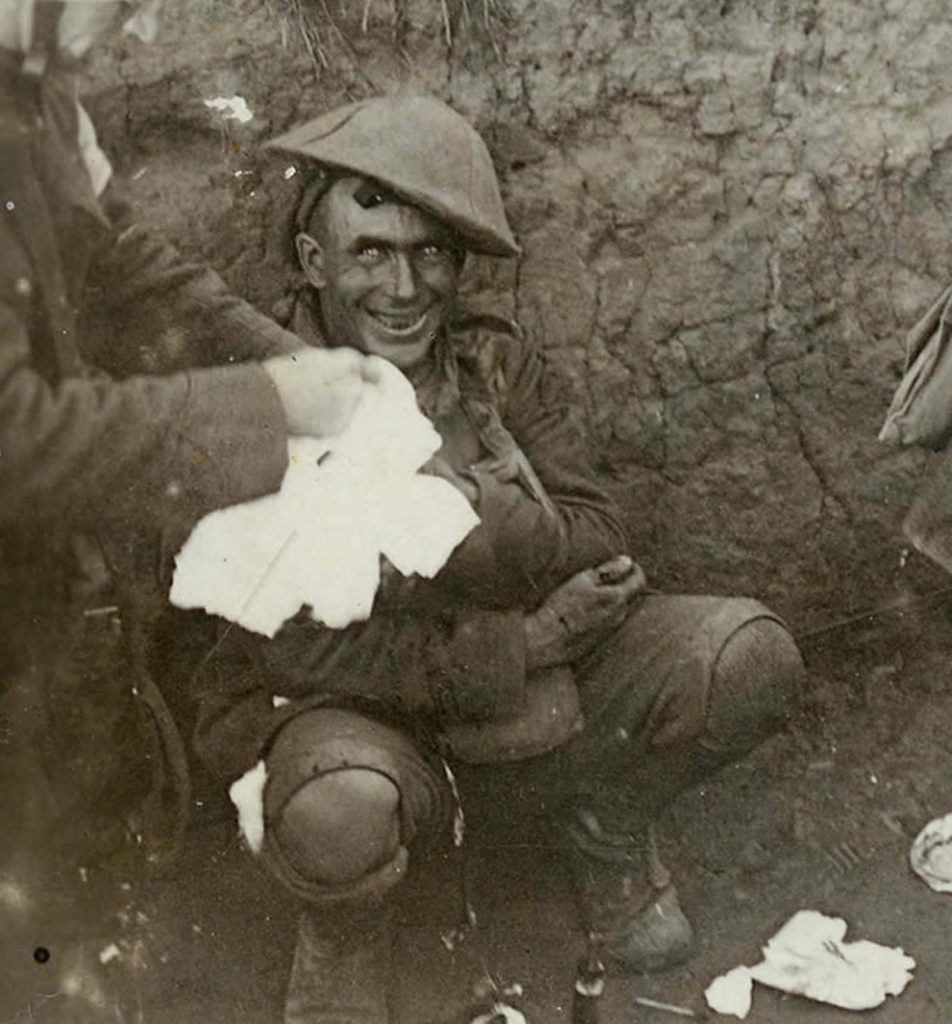Last updated on July 22nd, 2022 at 07:07 pm

War is hell, as the expression goes. The traumas soldiers endured during war were certainly far from just physical but psychological as well. This haunting photo in the trenches of the Battle of Flers-Courcelette in September 1916 during the Somme Offensive is a grim and haunting reminder of this psychological effect.
The Battle of Flers-Courcellette was fought by the French Sixth Army and the British Fourth Army against the 1st Army from Germany in September of 1916.
This third installment of the Battle of the Somme did not achieve a strategic objective of decisive victory when it concluded. Many Germans fell in this battle, but the villages of Martinpuich, Flers, and Courcelette were captured, yielding a sizable tactical victory. In addition, the defensive tactics by the Germans on the British right flank made cavalry utilization essentially impossible.
This was also the first battle in history to utilize the rudimentary versions of the contemporary tank and the first participation of the New Zealand Division and Canadian Corps in the Somme battle saga. It was also the first time that a German specialist fighter squadron, the Jagdstaffel 2, initiated operations with its five Albatros D.I. fighters, challenging the air supremacy of the British held in the Somme battle up to that point.
The soldier pictured was surely afraid for his life. He lay in the trench, seeing many of his fellow soldiers killed and stuck there for an unknown period, fearing for his own life. Leaving would mean death, and staying reduced the chances of death only nominally for a time. All of the known social constructs he was used to in everyday life had fallen away. Sanity is not far on the list when everything a human knows is stripped away.
Especially striking from the photo is the fact that the man is smiling while those around him have medics tending to their wounds. Of course, that’s before even mentioning that it was not traditional to smile for photos at that time.
This photograph was taken during World War I, which was warfare on a scale yet unknown to contemporary human generations, pushing hundreds of thousands of soldiers past beyond the limits of what their psyche could endure. It was the first conflict in human history that used modern weaponry, the type that reduced the chances of heroism and crumbled the courage of even the bravest soldier. It was hard not to do in the face of weapons with a 60% casualty rate and could be used effectively from miles away.
The soldiers who saw the condition of their fellow men having their psyches breached and broken coined a term to describe this phenomenon: “shell shock.” The symptoms included tremors, confusion, fatigue, being stuck in a dazed thousand-yard stare, nightmares, and more physical manifestations like impaired hearing and sight, hysterical paralysis, and the inability to reason coherently.
When a soldier was rendered unable to function without an obvious cause for this happening, the diagnosis of “shell shock” was attributed to their condition. It was stated that any soldier, even the most obedient, can only have so many shells rain down on him without any ability to fight back until all self-control is lost.
The term “shell shock” is no longer applied in medical practice or in combat condition diagnosis, but it remains a known relic in the memories and imaginations of those who hear it as an identifier of the signature psychological injury endured during the hell of war. The condition’s name evolved over time, changing to “war neurosis” and later to “battle fatigue.” It was also expanded to include dramatic physical difficulties being endured after wartime, in a common medical term of Post-Traumatic Stress Disorder (PTSD).
The most jarring aspect of experiences of shell shock by soldiers is that some of them were brought before a military tribunal for a trial, and some of those were even executed for cowardice and desertion. It wasn’t that the military heads denied the reality of the shell shock condition, but a prolonged reaction to the stresses of war was viewed as a fundamental lack of character. Some regarded it as a weakness, as Lord Gort stated in his Royal Commission post-war testimony, saying that this type of deficiency was not present in “good” military units.
The number of soldiers convicted of desertion or cowardice while going insane from shell shock is impossible to calculate. Still, with time, to help the troops, the British government pardoned those who were executed for these convicted crimes, leading to the official recognition of shell shock as a real psychological combat condition.

